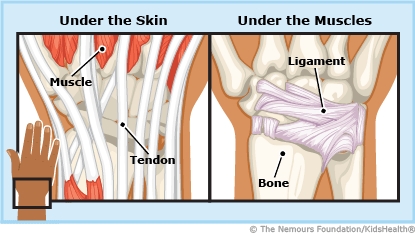Wrist Pain: How to Care for Your Child
Wrist pain can happen for many different reasons. It may be a dull ache or a sharp, shooting pain, and can come from different areas inside the wrist. The pain can come on slowly or suddenly, but in kids it usually gets better with rest. Follow these instructions to care for your child.


For pain, your child can:
-
Take ibuprofen (such as Advil®, Motrin®, or a store brand), if recommended by your health care provider. Follow the directions on the label for how much they should take and how often.
-
Place a cold pack wrapped in a towel on the area for 15–20 minutes a few times a day for the first few days after an injury. Put a towel or cloth between the cold pack and the skin.
-
Place a heat pack wrapped in a towel on the wrist for no longer than 20 minutes (being careful not to burn the skin) or have your child take a warm bath or shower. Heat packs can also help with stiffness.

Your child:
-
has pain that gets worse
-
has no improvement in the pain after a few days
-
has signs of infection, such as fever, swelling, warmth, or redness around the wrist

Your child has:

What causes wrist pain? Many things can cause wrist pain, such as:
-
overuse
-
using a computer keyboard the wrong way. When typing or using a mouse, your child's wrists should be in a neutral (straight) position.
-
sports or activities that involve repetitive wrist movements
-
an injury
-
other medical conditions, like an infection or inflammation
What can help prevent wrist pain? It may help for your child to:
-
Work with a sports trainer to make sure they don't overtrain and that they warm up and cool down correctly.
-
Use a wrist rest (small pad placed in front of a computer keyboard that supports the wrist) to help keep the wrists in a neutral position.